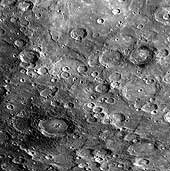|
COMETS EARTH JUPITER KUIPER BELT MARS MERCURY METEORITES NEPTUNE OORT CLOUD PLUTO SATURN SOLAR SYSTEM SPACE SUN URANUS VENUS ORDER PRINTS
PHOTO CATEGORIES SCIENCEVIEWS AMERICAN INDIAN AMPHIBIANS BIRDS BUGS FINE ART FOSSILS THE ISLANDS HISTORICAL PHOTOS MAMMALS OTHER PARKS PLANTS RELIGIOUS REPTILES SCIENCEVIEWS PRINTS
|
Related Documents
Download Options
As MESSENGER flew by Mercury, the Narrow Angle Camera (NAC) of the Mercury Dual Imaging System (MDIS) captured this view on January 14, 2008. Two of the larger craters in this image appear to have darkened crater rims and partial "halos" of dark material immediately surrounding the craters. Both craters appear to have nearly complete rims and interior terraced walls, suggesting that they formed more recently than the other nearby shallower craters of similar size. There are two possible explanations for their dark halos: (1) Darker subsurface material may have been excavated during the explosions from the asteroid or comet impacts that produced the craters. (2) Large cratering explosions may have melted a fraction of the rocky surface material involved in the explosions, splashing so-called "impact melts" across the surface; such melted rock is often darker (lower albedo) than the pre-impact target material. In either case, the association of the dark material with relatively recently formed craters suggests that the processes that gradually homogenize Mercury's surface materials have not yet had time to reduce the contrast of these dark halos. The crater with associated dark material in the lower-left part of this image is about 100 km (60 miles) in diameter, and the crater with patches of dark material in the upper right is about 70 km (40 miles) across. These dark-halo craters, located near Mercury's south pole, are also visible in the previously released false-color image created from three Wide Angle Camera (WAC) frames (see VSS00093). Information from images taken in the 11 different color filters of the WAC will help MESSENGER scientists to understand the nature of the dark material associated with the craters shown in this image and will determine whether they reveal the presence of subsurface material of a different composition, are examples of impact melt, or perhaps have some other explanation. Image Mission Elapsed Time (MET): 108828161 |
